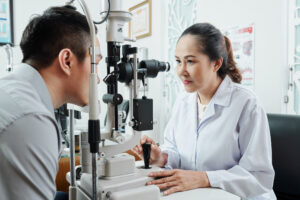November 1, 2023
By Dwight Akerman, OD, MBA, FAAO, FBCLA, FIACLE

Khan et al. (2023) conducted a retrospective analysis of a large dataset of young adult myopes to characterize myopia progression during adulthood. The study aimed to determine the mean annual progression of myopia and to estimate the proportion of progressors in adult myopes. The authors analyzed longitudinal, non-cycloplegic subjective refraction data for young adult myopes (spherical equivalent refractive error -0.50D or more), age ranging from 18-30 years.
The study found that the mean annual progression of myopia was -0.10 [0.21] D, -0.08 [0.2] D, and -0.04 [0.21] D in 18-21-year, 22-26 year, and 27-30-year age groups, respectively (P = .003). The difference between 18-21- and 27-30-year age groups was significant (P = .05), while all other pairwise comparisons were not significant. The proportion (95% CI) of progressors in the 18-21, >21-26, and >26–30-year groups was 18.3% (14.9, 21.7), 10.9% (7.1, 14.7), and 8.8% (4.4, 13.1), respectively.
The study also found that the proportion of progressors working or studying in a higher learning/academic environment was 16.2% with an OR (95%CI) for progression of 2.07 (1.15 – 3.74) compared to those in non-academic environments (P = .02), with no significant effect of gender or ethnicity.
In conclusion, Khan et al.’s retrospective analysis provides valuable insights into the progression of myopia in adults, which is a relatively understudied area of research. This study found that the mean annual progression of myopia decreases with age and that the proportion of progressors is higher among young adults aged between 18-21 years than those aged between 22-30 years old. Additionally, the study found that individuals working or studying in a higher learning/academic environment are more likely to experience myopia progression than those in non-academic environments.
Abstract
Myopia Progression in Adults: A Retrospective Analysis
Hashim Ali Khan, Thomas Naduvilath, Nina Tahhan, Padmaja R Sankaridurg
Significance: Studies on adult myopia progression are limited. This retrospective analysis of a large data set of young adult myopes characterizes myopia progression during adulthood.
Purpose: This study aimed to determine the mean annual progression of myopia and to estimate the proportion of progressors in adult myopes.
Methods: Longitudinal, noncycloplegic subjective refraction data for young adult myopes (spherical equivalent refractive error, -0.50 D or more), age ranging from 18 to 30 years, were retrospectively analyzed. The mean annual progression, as well as the proportion of progressors (at least -0.50 D shift between visits and annualized progression of -0.25 D or more), was estimated.
Results: A total of 354 myopes (230 females [64.7%]), with a mean (standard deviation) age of 22.2 (3.8) years, were considered. The mean (standard deviation) annualized progression was -0.10 (0.21), -0.08 (0.2), and -0.04 (0.21) D in the 18- to 21-year, 22- to 26-year, and 27- to 30-year age groups, respectively (P = .003). The difference between 18- to 21- and 27- to 30-year age groups was significant (P = .05), whereas all other pairwise comparisons were not significant. The proportion (95% confidence interval) of progressors in the 18- to 21-, >21- to 26-, and >26- to 30-year age groups was 18.3% (14.9 to 21.7%), 10.9% (7.1 to 14.7%), and 8.8% (4.4 to 13.1%), respectively. The proportion of progressors working or studying in a higher learning/academic environment was 16.2% with an odds ratio (95% confidence interval) for progression of 2.07 (1.15 to 3.74) compared with those in nonacademic environments (P = .02), with no significant effect of sex or ethnicity.
Conclusions: This study is consistent with other studies on myopia in young adults, which show that myopia does not progress by substantial amounts throughout the adult years, particularly after the age of 21 years. Although future studies may be challenged by the small rates of change and the small proportion of progressors, further research is needed to understand the implications of adult myopia progression on clinical management.
Khan, H. A., Naduvilath, T., Tahhan, N., & Sankaridurg, P. R. (2023). Myopia Progression in Adults: A Retrospective Analysis. Optometry and Vision Science, 100(8), 537-542.
DOI: https://doi.org/10.1097/opx.0000000000002045













